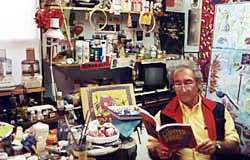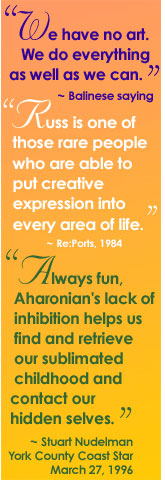 |
|
 |
|
 |
I grow my art rather than make it. Even as a child, growing up in North Andover, I would dig up clay by the river and form figures, paint the walls of the barn crazy colors using rollers. I’d go to the library when I was really little and look at art books. I loved Hieronymus Bosch because his paintings were really funny, and there were naked women. I didn't know any artists growing up. I am dyslexic and had a hard time in academics. When my high school guidance counselor asked if I was interested in art, I said no and joined the Navy. But when we were in port in Greece, Italy and Spain, I went to all the museums and galleries. I loved Gaudi and particularly Miro because of his humor. His images were happy, his colors bright. When I’m working, I get lost in inner and outer space, working from random to deliberate. As I get older, I realize there is no time, only the moment. I try to stay awake and aware and give my intuition all the space it needs. It’s a process parallel to life: you make mistakes, you correct them and then you go on. But in art, the mistakes give you more choices, open more doors. I draw from all experience in my life, from working construction, reading about the body and animals, family friends, other artists’ work. When I see something I wish I had done, that’s when I know it’s good. I used to always start from something from the outside, from art history, or a model, images for a collage, or Asian art, but now it all comes from inside. Any work where the artist put all their love into it--I don’t think it matters if it’s realistic or surreal--it’s when you put all that love into it, that’s what makes real art. Ultimately, the viewer brings the beauty and value to the art, ideally becoming one with the images, spending time with the work. People see what they want to see. I am often surprised by what I create, and I want the viewer to have a similar experience of astonishment, to feel some balance of contrast, rhythm and the beauty of living and being alive. |

|
||